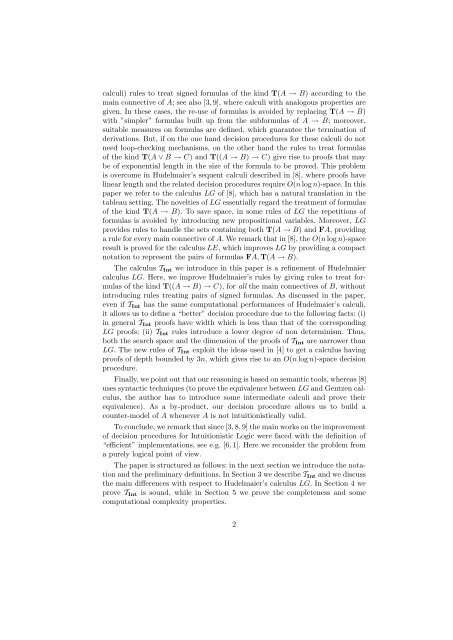A refined calculus for Intuitionistic Propositional Logic - DISCo
A refined calculus for Intuitionistic Propositional Logic - DISCo
A refined calculus for Intuitionistic Propositional Logic - DISCo
Create successful ePaper yourself
Turn your PDF publications into a flip-book with our unique Google optimized e-Paper software.
calculi) rules to treat signed <strong>for</strong>mulas of the kind T(A → B) according to themain connective of A; see also [3, 9], where calculi with analogous properties aregiven. In these cases, the re-use of <strong>for</strong>mulas is avoided by replacing T(A → B)with ”simpler” <strong>for</strong>mulas built up from the sub<strong>for</strong>mulas of A → B; moreover,suitable measures on <strong>for</strong>mulas are defined, which guarantee the termination ofderivations. But, if on the one hand decision procedures <strong>for</strong> these calculi do notneed loop-checking mechanisms, on the other hand the rules to treat <strong>for</strong>mulasof the kind T(A ∨ B → C) and T((A → B) → C) give rise to proofs that maybe of exponential length in the size of the <strong>for</strong>mula to be proved. This problemis overcome in Hudelmaier’s sequent calculi described in [8], where proofs havelinear length and the related decision procedures require O(n log n)-space. In thispaper we refer to the <strong>calculus</strong> LG of [8], which has a natural translation in thetableau setting. The novelties of LG essentially regard the treatment of <strong>for</strong>mulasof the kind T(A → B). To save space, in some rules of LG the repetitions of<strong>for</strong>mulas is avoided by introducing new propositional variables. Moreover, LGprovides rules to handle the sets containing both T(A → B) and FA, providinga rule <strong>for</strong> every main connective of A. We remark that in [8], the O(n log n)-spaceresult is proved <strong>for</strong> the <strong>calculus</strong> LE, which improves LG by providing a compactnotation to represent the pairs of <strong>for</strong>mulas FA, T(A → B).The <strong>calculus</strong> T Int we introduce in this paper is a refinement of Hudelmaier<strong>calculus</strong> LG. Here, we improve Hudelmaier’s rules by giving rules to treat <strong>for</strong>mulasof the kind T((A → B) → C), <strong>for</strong> all the main connectives of B, withoutintroducing rules treating pairs of signed <strong>for</strong>mulas. As discussed in the paper,even if T Int has the same computational per<strong>for</strong>mances of Hudelmaier’s calculi,it allows us to define a “better” decision procedure due to the following facts: (i)in general T Int proofs have width which is less than that of the correspondingLG proofs; (ii) T Int rules introduce a lower degree of non determinism. Thus,both the search space and the dimension of the proofs of T Int are narrower thanLG. The new rules of T Int exploit the ideas used in [4] to get a <strong>calculus</strong> havingproofs of depth bounded by 3n, which gives rise to an O(n log n)-space decisionprocedure.Finally, we point out that our reasoning is based on semantic tools, whereas [8]uses syntactic techniques (to prove the equivalence between LG and Gentzen <strong>calculus</strong>,the author has to introduce some intermediate calculi and prove theirequivalence). As a by-product, our decision procedure allows us to build acounter-model of A whenever A is not intuitionistically valid.To conclude, we remark that since [3, 8, 9] the main works on the improvementof decision procedures <strong>for</strong> <strong>Intuitionistic</strong> <strong>Logic</strong> were faced with the definition of“efficient” implementations, see e.g. [6, 1]. Here we reconsider the problem froma purely logical point of view.The paper is structured as follows: in the next section we introduce the notationand the preliminary definitions. In Section 3 we describe T Int and we discussthe main differences with respect to Hudelmaier’s <strong>calculus</strong> LG. In Section 4 weprove T Int is sound, while in Section 5 we prove the completeness and somecomputational complexity properties.2
















